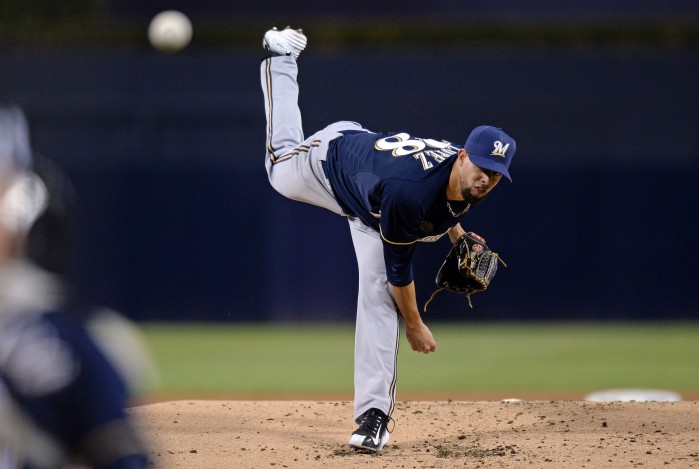Top-prospect lists are not what people desire them to be. They don’t rank how likely minor-league players are to stick in the majors and find success. They shouldn’t guarantee what a prospect will become in the future, nor should they pretend to foresee all possible paths of development. In the end, prospect lists are best utilized to take a snapshot of a farm system and of the individual prospects within that system — a storytelling tool to depict what is currently happening.
Almost as soon as a prospect list is written and published, it becomes obsolete. It no longer represents what is; rather, it represents what was at a particular moment. Velocities fluctuate, new prospects are added to the system, a hitter changes his stance, a guy is bumped up a level, a player goes on a massive hot streak where something clicks. Prospect development is far too fluid for a single scouting report or a single top-10 list to be authoritative for a long period of time.
As such, it’s important to remain open and to be willing to alter one’s opinion about a player as new information is presented.
*****
The Milwaukee Brewers selected Jorge Lopez in the second round of the 2011 draft out of Puerto Rico. He immediately earned plaudits from scouts and prospect experts, with some suggesting he was the cream of the crop in the Brewers’ draft class that year. Those people loved Lopez’s frame, his demeanor, and his projectability. It led Baseball Prospectus’ Kevin Goldstein — who is now with the Houston Astros — to opine, “He could be a star, but it could take a decade to see it.”
After his professional debut, though, his prospect stock began to quickly deteriorate. In 2012 the right-hander struggled so much in Maryvale that the organization sent him to the Dominican complex, where he posted a 4.76 ERA in just five outings. It didn’t improve much the following season, either, as Lopez compiled an unsightly 5.23 ERA with Class-A Wisconsin as a 20-year-old.
All of that led to Baseball Prospectus leaving Lopez off the Brewers’ top-10 prospect list in 2014. His brief writeup still emphasized his long-term projectability; however, his overall ranking reflected his current status. In other words, leaving the hurler off the top-10 list was not an indication that he failed as a prospect or that he couldn’t make the big leagues. At that moment in time, though, the combination of production, current skills, and long-term projection didn’t make him one of the top-10 prospects in a weak Brewers’ farm system.
Perhaps the 2015 season best represents the fickle nature of prospect lists. Baseball Prospectus listed Lopez as the seventh-best player in the Brewers’ system. It noted that his realistic role was that of a number-five starter or a swingman, while still discussing his potential to be something more. Still, the scouting report said that he had “yet to realize [his] previously projected velocity jump” and did its best to capture what was the case at the moment of publication.
No more than six months later, that whole scouting report was relatively useless. Jorge Lopez experienced that velocity jump into the mid-90s. He put together a brilliant campaign for Double-A Biloxi, in which he posted a sparkling 2.32 ERA over 143.1 innings and won the Brewers’ Minor League Pitcher of the Year award. Moreover, the 6-foot-4 righty began throwing his curveball and changeup for strikes more often, giving him a legitimate chance to stick in a major-league rotation for the first time throughout his development process.
As such, his stock soared this year. Some scouts suggested that he should be in the conversation for the midseason top-100 prospect lists, while he cemented himself as an easy top-five prospect in a rapidly improving Brewers’ farm system by the end of July.
But this wasn’t an example of old scouting reports being wrong or unexpected development. Instead, these Baseball Prospectus lists reflected his overall journey, moving him up or down depending on what he showed at any given moment, but none of the scouting reports ever neglected to mention his projectability or his potential to take a massive step forward. If anything, as the seasons rolled along, the scouting reports merely questioned if it was going to happen.
Despite surrendering three runs in just five innings of his major-league debut on Tuesday, September 29, Lopez’s increased stock was on full display. He averaged 95 mph with his fastball, even touching 96.7 mph on one occasion. It showed a bit of wiggle, too, as evidenced by his seven swing-and-misses on the night. A 10.1 percent swinging-strike rate on his fastball is impressive, no matter the ultimate results on the scoreboard.
Lopez also featured the two things that now give him a chance to stick as a starter in the majors. His curveball has always been his primary offspeed offering — though he only threw eight of them on Tuesday — but 75 percent of his curveballs went for strikes. That’s absolutely key for the young right-hander.
Furthermore, he unleashed 16 changeups, a pitch that wasn’t legitimately in his repertoire a couple years ago. It’s a bit harder than one would like, as it averaged 89.3 mph and touched 91.2 mph, but he got three whiffs on his changeup and it has decent enough movement. The interesting thing, though, is that he threw a higher percentage of curveballs to lefties than changeups, featuring el cambio more against same-handed hitters.
Lopez has finally taken the elusive next step that everyone has projected for the last four years. It was never pre-ordained. His stock fell as the years progressed and he didn’t live up to his lofty projection. Now, though, he has become a legitimate top-100 prospect and is one of the brightest arms in the Brewers’ system. Such is the fickle nature of top prospect lists and why they should be mined for content, rather than rankings.
